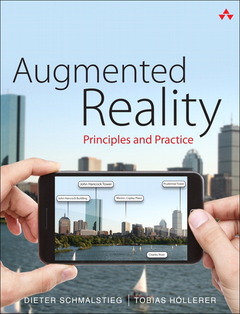Augmented Reality Principles and Practice Usability Series
Auteurs : Schmalstieg Dieter, Hollerer Tobias

Today?s Comprehensive and Authoritative Guide to Augmented Reality
By overlaying computer-generated information on the real world, augmented reality (AR) amplifies human perception and cognition in remarkable ways. Working in this fast-growing field requires knowledge of multiple disciplines, including computer vision, computer graphics, and human-computer interaction. Augmented Reality: Principles and Practice integrates all this knowledge into a single-source reference, presenting today?s most significant work with scrupulous accuracy. Pioneering researchers Dieter Schmalstieg and Tobias Höllerer carefully balance principles and practice, illuminating AR from technical, methodological, and user perspectives.
Coverage includes
- Displays: head-mounted, handheld, projective, auditory, and haptic
- Tracking/sensing, including physical principles, sensor fusion, and real-time computer vision
- Calibration/registration, ensuring repeatable, accurate, coherent behavior
- Seamless blending of real and virtual objects
- Visualization to enhance intuitive understanding
- Interaction?from situated browsing to full 3D interaction
- Modeling new geometric content
- Authoring AR presentations and databases
- Architecting AR systems with real-time, multimedia, and distributed elements
This guide is indispensable for anyone interested in AR, including developers, engineers, students, instructors, researchers, and serious hobbyists.
Preface xix
Acknowledgments xxv
About the Authors xxvii
Chapter 1: Introduction to Augmented Reality 1
Definition and Scope 3
A Brief History of Augmented Reality 4
Examples 13
Related Fields 28
Summary 31
Chapter 2: Displays 33
Multimodal Displays 34
Visual Perception 39
Requirements and Characteristics 40
Spatial Display Model 56
Visual Displays 58
Summary 84
Chapter 3: Tracking 85
Tracking, Calibration, and Registration 86
Coordinate Systems 87
Characteristics of Tracking Technology 90
Stationary Tracking Systems 96
Mobile Sensors 99
Optical Tracking 105
Sensor Fusion 117
Summary 120
Chapter 4: Computer Vision for Augmented Reality 121
Marker Tracking 123
Multiple-Camera Infrared Tracking 132
Natural Feature Tracking by Detection 138
Incremental Tracking 149
Simultaneous Localization and Mapping 156
Outdoor Tracking 164
Summary 176
Chapter 5: Calibration and Registration 179
Camera Calibration 180
Display Calibration 183
Registration 190
Summary 194
Chapter 6: Visual Coherence 195
Registration 196
Occlusion 199
Photometric Registration 205
Common Illumination 216
Diminished Reality 227
Camera Simulation 231
Stylized Augmented Reality 236
Summary 237
Chapter 7: Situated Visualization 239
Challenges 241
Visualization Registration 245
Annotations and Labeling 248
X-Ray Visualization 254
Spatial Manipulation 260
Information Filtering 265
Summary 270
Chapter 8: Interaction 271
Output Modalities 272
Input Modalities 279
Tangible Interfaces 286
Virtual User Interfaces on Real Surfaces 294
Augmented Paper 295
Multi-view Interfaces 297
Haptic Interaction 304
Multimodal Interaction 304
Conversational Agents 306
Summary 309
Chapter 9: Modeling and Annotation 311
Specifying Geometry 312
Specifying Appearance 317
Semi-automatic Reconstruction 319
Free-Form Modeling 322
Annotation 325
Summary 328
Chapter 10: Authoring 329
Requirements of AR Authoring 330
Elements of Authoring 333
Stand-Alone Authoring Solutions 335
Plug-In Approaches 339
Web Technology 341
Summary 342
Chapter 11: Navigation 345
Foundations of Human Navigation 346
Exploration and Discovery 347
Route Visualization 347
Viewpoint Guidance 350
Multiple Perspectives 354
Summary 360
Chapter 12: Collaboration 361
Properties of Collaboration Systems 362
Co-located Collaboration 364
Remote Collaboration 370
Summary 377
Chapter 13: Software Architectures 379
AR Application Requirements 380
Software Engineering Requirements 382
Distributed Object Systems 385
Dataflow 389
Scene Graphs 395
Developer Support 400
Summary 407
Chapter 14: The Future 409
What May Drive Business Cases 410
An AR Developer’s Wish List 411
Taking AR Outdoors 415
Interfacing with Smart Objects 417
Confluence of Virtual Reality and Augmented Reality 418
Augmented Humans 419
AR as a Dramatic Medium 420
AR as a Social Computing Platform 421
Summary 422
References 423
Index 473
Dieter Schmalstieg is professor and head of the Institute for Computer Graphics and Vision at Graz University of Technology (TUG), Austria. His current research interests are augmented reality, virtual reality, real-time graphics, 3D user interfaces, and visualization. He received Dipl.-Ing. (1993), Dr. techn. (1997) and Habilitation (2001) degrees from Vienna University of Technology. He is author and coauthor of more than two hundred peer-reviewed scientific publications, associate editor of IEEE Transactions on Visualization and Computer Graphics, member of the editorial advisory board of computers and graphics and of Springer Virtual Reality, member of the steering committee of the IEEE International Symposium on Mixed and Augmented Reality, chair of the EUROGRAPHICS working group on Virtual Environments (1999-2010), advisor of the K-Plus Competence Center for Virtual Reality and Visualization in Vienna, and member of the Austrian Academy of Science. In 2002, he received the START career award presented by the Austrian Science Fund. In 2012, he received the IEEE Virtual Reality Technical Achievement Award for seminal contributions to the field of augmented reality. Since 2008, he is also director of the Christian Doppler Laboratory for Handheld Augmented Reality.
Tobias Höllerer is professor of computer science at the University of California, Santa Barbara, where he leads the Four Eyes Laboratory, conducting research in the four I's of Imaging, Interaction, and Innovative Interfaces. Dr. Höllerer holds a Diplom in informatics from the Technical University of Berlin, as well as an M.S. and Ph.D. in computer science from Columbia University. He is a recipient of the U.S. National Science Foundation's CAREER award for his work on "Anywhere Augmentation." enabling mobile computer users to place annotations in 3D space wherever they go. In 2013, he was named an ACM Distinguished Scientist. Dr. Höllerer is author of more th
- The first comprehensive, coherent, and authoritative guide to Augmented Reality: integrates key advances in all areas of the field
- An indispensable single-source reference for students
- Lead author Dieter Schmalstieg is a leading AR pioneer: this book reflects both his deep grasp of AR theory and his longtime work with industry
- Includes numerous case studies plus a hands-on guide to Android AR development with Qualcomm QCAR
Date de parution : 06-2016
Ouvrage de 528 p.
18x22.5 cm



